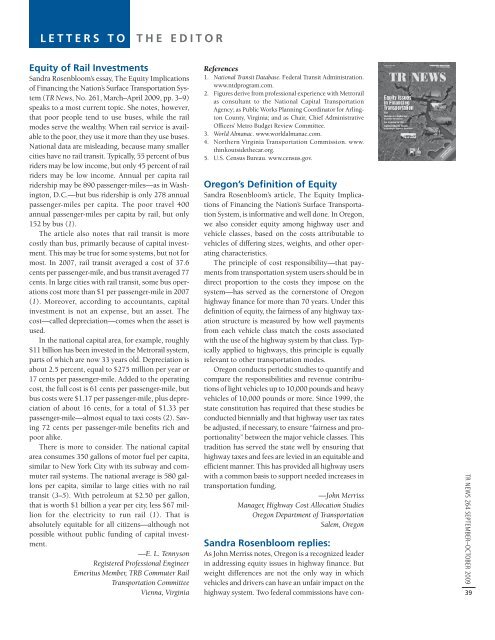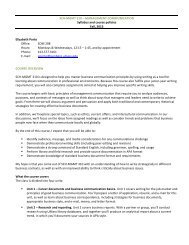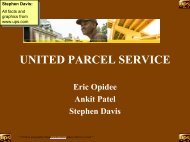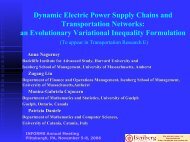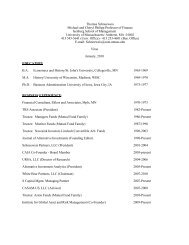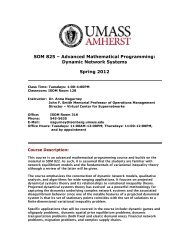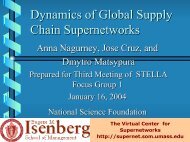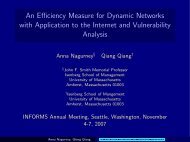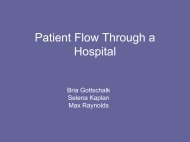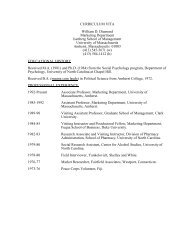TR News - Transportation Research Board
TR News - Transportation Research Board
TR News - Transportation Research Board
- No tags were found...
You also want an ePaper? Increase the reach of your titles
YUMPU automatically turns print PDFs into web optimized ePapers that Google loves.
LETTERS TO THE EDITOREquity of Rail InvestmentsSandra Rosenbloom’s essay, The Equity Implicationsof Financing the Nation’s Surface <strong>Transportation</strong> System(<strong>TR</strong> <strong>News</strong>, No. 261, March–April 2009, pp. 3–9)speaks to a most current topic. She notes, however,that poor people tend to use buses, while the railmodes serve the wealthy. When rail service is availableto the poor, they use it more than they use buses.National data are misleading, because many smallercities have no rail transit. Typically, 55 percent of busriders may be low income, but only 45 percent of railriders may be low income. Annual per capita railridership may be 890 passenger-miles—as in Washington,D.C.—but bus ridership is only 278 annualpassenger-miles per capita. The poor travel 400annual passenger-miles per capita by rail, but only152 by bus (1).The article also notes that rail transit is morecostly than bus, primarily because of capital investment.This may be true for some systems, but not formost. In 2007, rail transit averaged a cost of 37.6cents per passenger-mile, and bus transit averaged 77cents. In large cities with rail transit, some bus operationscost more than $1 per passenger-mile in 2007(1). Moreover, according to accountants, capitalinvestment is not an expense, but an asset. Thecost—called depreciation—comes when the asset isused.In the national capital area, for example, roughly$11 billion has been invested in the Metrorail system,parts of which are now 33 years old. Depreciation isabout 2.5 percent, equal to $275 million per year or17 cents per passenger-mile. Added to the operatingcost, the full cost is 61 cents per passenger-mile, butbus costs were $1.17 per passenger-mile, plus depreciationof about 16 cents, for a total of $1.33 perpassenger-mile—almost equal to taxi costs (2). Saving72 cents per passenger-mile benefits rich andpoor alike.There is more to consider. The national capitalarea consumes 350 gallons of motor fuel per capita,similar to New York City with its subway and commuterrail systems. The national average is 580 gallonsper capita, similar to large cities with no railtransit (3–5). With petroleum at $2.50 per gallon,that is worth $1 billion a year per city, less $67 millionfor the electricity to run rail (1). That isabsolutely equitable for all citizens—although notpossible without public funding of capital investment.—E. L. TennysonRegistered Professional EngineerEmeritus Member, <strong>TR</strong>B Commuter Rail<strong>Transportation</strong> CommitteeVienna, VirginiaReferences1. National Transit Database. Federal Transit Administration.www.ntdprogram.com.2. Figures derive from professional experience with Metrorailas consultant to the National Capital <strong>Transportation</strong>Agency; as Public Works Planning Coordinator for ArlingtonCounty, Virginia; and as Chair, Chief AdministrativeOfficers’ Metro Budget Review Committee.3. World Almanac. www.worldalmanac.com.4. Northern Virginia <strong>Transportation</strong> Commission. www.thinkoutsidethecar.org.5. U.S. Census Bureau. www.census.gov.Oregon’s Definition of EquitySandra Rosenbloom’s article, The Equity Implicationsof Financing the Nation’s Surface <strong>Transportation</strong>System, is informative and well done. In Oregon,we also consider equity among highway user andvehicle classes, based on the costs attributable tovehicles of differing sizes, weights, and other operatingcharacteristics.The principle of cost responsibility—that paymentsfrom transportation system users should be indirect proportion to the costs they impose on thesystem—has served as the cornerstone of Oregonhighway finance for more than 70 years. Under thisdefinition of equity, the fairness of any highway taxationstructure is measured by how well paymentsfrom each vehicle class match the costs associatedwith the use of the highway system by that class. Typicallyapplied to highways, this principle is equallyrelevant to other transportation modes.Oregon conducts periodic studies to quantify andcompare the responsibilities and revenue contributionsof light vehicles up to 10,000 pounds and heavyvehicles of 10,000 pounds or more. Since 1999, thestate constitution has required that these studies beconducted biennially and that highway user tax ratesbe adjusted, if necessary, to ensure “fairness and proportionality”between the major vehicle classes. Thistradition has served the state well by ensuring thathighway taxes and fees are levied in an equitable andefficient manner. This has provided all highway userswith a common basis to support needed increases intransportation funding.—John MerrissManager, Highway Cost Allocation StudiesOregon Department of <strong>Transportation</strong>Salem, OregonSandra Rosenbloom replies:As John Merriss notes, Oregon is a recognized leaderin addressing equity issues in highway finance. Butweight differences are not the only way in whichvehicles and drivers can have an unfair impact on thehighway system. Two federal commissions have con-<strong>TR</strong> NEWS 264 SEPTEMBER–OCTOBER 200939


